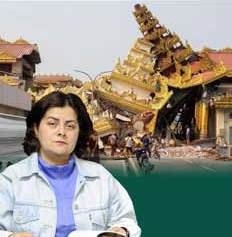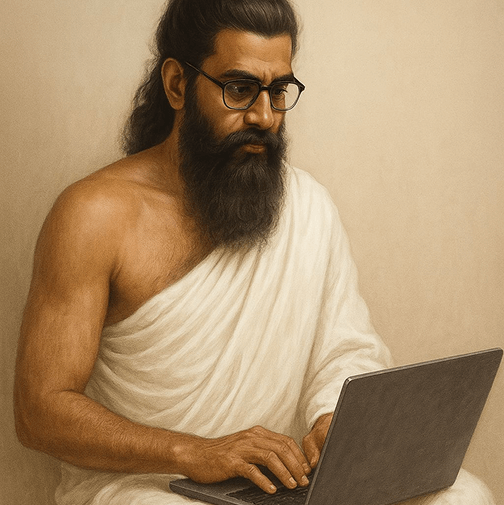There's a meme doing the rounds on Facebook about Modi's recent visit:
During his visit to Sri Lanka, the Indian Prime Minister, seated in a car with his host, President Anura Kumara Dissanayake, looked around with mild confusion and said: "This is my fourth visit to Sri Lanka. Every time I came before, there were always crowds of angry people in black shirts, waving black flags and shouting anti-Indian slogans— accusing us of expansionism and imperialism. But this time... not a single protester in sight. Have they changed their view of India? Or... did we just take a different route?"
To this, Anura Kumara grinned and replied: "We were those guys. Now we're running the country. We know we can't go around antagonising a regional superpower anymore."
Sri Lanka witnessed a once-in-a-lifetime reception for a foreign leader during the recent visit of Indian Prime Minister Narendra Modi. Beyond the optics, the two countries signed several key agreements—including a landmark defence cooperation pact that previous governments had either hesitated to pursue or outright avoided.
It's almost amusing—and at the same time, commendable for its pragmatism—to see how far the JVP has come. Once a party that gained traction largely through its strong anti-Indian rhetoric, it now leads a government under the NPP banner that is pragmatic enough to understand the real demands of governance.
Anura Kumara Dissanayake and the JVP's powerful decision-making Politburo have clearly realized that you can't govern a country like Zelensky's Ukraine or Hamas's Gaza—through constant confrontation, idealistic defiance, or by antagonizing
global superpowers. This world belongs to pragmatists, not to mythical warrior-kings who ride into battle driven by rigid belief systems, only to fall with arrows in their chests.
From Anti-India Firebrand to Pragmatic Partner: JVP's Political Evolution
The JVP was born as a Marxist-Leninist revolutionary movement, the brainchild of Rohana Wijeweera—a Moscow-educated medical student who was more of a firebrand agitator than a pragmatic ideologue. Both he and the JVP were ideologically shaped by global leftist currents, drawing inspiration from figures like Mao Zedong, Vladimir Lenin, Che Guevara, and other revolutionary thinkers. In its early years, the JVP embraced class struggle, militant activism, and a staunch opposition to the prevailing political and economic order.
Its first uprising in 1971, though amateurish in organization, was a radical experiment led by idealistic and inexperienced youth. Despite its limited military success, the rebellion shook the nation—primarily because of the state's brutal crackdown, which resulted in the deaths of thousands.
By the late 1980s, as New Delhi deepened its involvement in Sri Lanka's ethnic conflict—particularly through its support to Tamil militant groups and the eventual signing of the Indo-Lanka Accord—the JVP re-emerged with renewed vigor and a new target for its revolutionary ire: India.
With the signing of the Indo-Lanka Accord in 1987, Rohana Wijeweera and his comrades no longer viewed India as a benign neighbor but as a neo-imperialist power intent on undermining Sri Lankan sovereignty.
JVP propaganda during this period portrayed India as a regional bully—an "expansionist" force not unlike Western imperialists. The party's literature, public speeches, and posters accused India of plotting to turn Sri Lanka into a client state. This anti-Indian narrative became deeply institutionalized within the movement.
Oaths reportedly taken by JVP recruits at the time allegedly included a vow to "resist all forms of foreign intervention, especially Indian expansionism." One of the JVP's foundational 'Five Lectures,' delivered by Wijeweera himself, was dedicated entirely to the threat of Indian imperialism, emphasizing the belief that India aimed to undermine Sri Lanka's sovereignty.
Wijeweera, known for his fiery speeches, once declared: "India is not helping Sri Lanka out of goodwill. Its long-term plan is to divide and dominate us." This anti-India sentiment wasn't just part of the party's internal discourse—it shaped its propaganda, recruitment, and actions during the height of its second insurrection.
Fiery Rebellion and Anti-Indian Rhetoric in the 1980s
The Indo-Lanka Peace Accord of 1987—an agreement that brought the Indian Peace Keeping Force (IPKF) into Sri Lanka and introduced devolution through the 13th Amendment—was, to the JVP, nothing short of an Indian invasion cloaked in diplomacy. The party erupted in fury, launching street agitations, incendiary propaganda, and a campaign of targeted violence to resist what it perceived as a betrayal by Colombo and the imposition of a "Delhi diktat."
Rohana Wijeweera publicly denounced the
presence of Indian troops, declaring them an "occupying army" sent not to preserve peace but to "subdue the will of the Sri Lankan people." He warned that unless Sri Lankans resisted, the island risked becoming "another province of India"—a satellite state with its sovereignty quietly extinguished.
Such rhetoric resonated deeply with segments of the Sinhala nationalist base, who were already wary of India's intentions. The JVP skillfully tapped into this resentment, converting popular frustration into a militant uprising. Between 1987 and 1989, the party launched a full-blown insurrection, marked by assassinations, sabotage, and open confrontation with the state—a conflict that resulted in the deaths of tens of thousands of Sri Lankans on both sides.
In justifying the turn to armed rebellion, Wijeweera framed it as a last resort. "When the state surrenders the nation to foreign powers," he argued, "it becomes not only our right but our duty to take up arms in defense of the motherland."
The JVP began targeting individuals they accused of collaborating with India—branding them as traitors. In response, the Sri Lankan government unleashed a brutal counter-insurgency campaign, targeting not only active JVP members but also suspected sympathizers and even those who merely expressed mild dissent.
Scores of people—mostly young men and women—were killed by both sides in an orgy of violence. This tragic scenario is perhaps best captured by the words of the legendary writer Khushwant Singh in his novel Train to Pakistan: "In truth, both sides killed. Both shot and stabbed and speared and clubbed. Both tortured. Both raped." His words, though written about another time and place, hauntingly echo the Sri Lankan experience during the JVP insurrection.
The same JVP-led government that now champions the rule of law and justice has arrested former Eastern Province Chief Minister Sivanesathurai Chandrakanthan—better known as Pillayan—in connection with the 2006 abduction and suspected murder of Professor S. Raveendranath, then Vice Chancellor of Eastern University. The case, still unresolved after 18 years, remains one of the darkest chapters in Sri Lanka's academic history. If Pillayan is guilty, justice must be served—without hesitation, without compromise.
But here's the bitter irony: Pillayan stands accused of a murder 18 years ago. Yet the JVP itself committed murders 18 years before that. In the blood-soaked late 1980s, it was the JVP that gunned down scholars, vice chancellors, and teachers. It was the JVP that pioneered the systematic targeting of intellectuals, branding those who refused to bow to their radical ideology as "traitors," and executing them with cold precision.
Among their first victims was Professor Stanley Wijesundera, the revered first Vice Chancellor of the University of Colombo. A visionary scholar and a symbol of academic independence, he was shot dead inside the Library Room at College House in 1989—his only 'crime' was defying the JVP's demand to shut down the university.
Soon after, Professor Chandratne Patuwathavithane, Vice Chancellor of the University of Moratuwa, was gunned down in his office in September 1989 for refusing to yield to JVP threats. The blood didn't stop there. The JVP's guns turned toward anyone who stood in their way:
Dr. Gladys Jayawardene, Chairperson of the State Pharmaceuticals Corporation—was gunned down in 1989.
Ven. Kotikawatte Saddhatissa Thera, a respected Buddhist monk and voice of moderation.
Thevis Guruge, Chairman of the Sri Lanka Broadcasting Corporation—was silenced forever.
Premakeerthi de Alwis, the beloved lyricist and broadcaster—was slaughtered simply for being a public figure who didn't sing their tune.
Hundreds of teachers, doctors, monks, public servants, and media personnel were murdered during the 1987–1989 JVP insurrection. Their only fault was choosing reason over revolution, moderation over madness, and Sri Lanka over a blood-soaked dream.
And the JVP had the audacity to justify these killings. They called their victims "traitors." But history remembers them as patriots.
The government, too, responded with barbaric force. In its effort to crush the JVP insurrection, it deployed every brutal tactic from the counterinsurgency playbook—mass arrests, extrajudicial killings, torture, and disappearances became commonplace.
By the time the insurrection was finally quelled in late 1989, estimates suggest that between 40,000 and 60,000 people—mostly young Sinhalese men and women—had lost their lives. The JVP's top leadership was decimated, and its militant machinery was dismantled.
Its anti-Indian crusade exacted a horrific toll—not only in lives but also on the national psyche—leaving behind a complex legacy of trauma and deep-rooted mistrust toward India.
JVP's Rebirth as the NPP
Over the next two decades, the JVP gradually shed much of its militant baggage. It contested elections, entered parliament, and even joined coalition governments briefly. Under Somawansa Amarasinghe and later Anura Kumara Dissanayake, the JVP moderated its ideology, moving away from insurrectionary Marxism toward a platform of anti-corruption, social justice, and good governance.
In this transformation, the JVP's strident anti-India line also began to soften. The new generation of leaders recognized that to be a credible national force – one aiming to govern, not just protest – they could ill afford the ideological rigidity of the past.
When Indian Prime Minister Narendra Modi visited Sri Lanka, NPP politicians displayed none of the hostility their party elders once harbored. Anura Kumara Dissanayake himself spoke of the "mutual respect" between Sri Lanka and India—a far cry from Rohana Wijeweera's caustic denunciations decades ago. Notably, the JVP's 1980s-era rhetoric portraying India as an imperialist oppressor is absent from the NPP's current discourse.
Pragmatism Over Dogma: A Calculated Shift
What explains this stunning about-face in the JVP's stance toward India? At first glance, it might appear hypocritical—how does a party go from oath-bound anti-Indian militancy to signing defence agreements with the very same nation? But a closer, more analytical look suggests something else.
The ideological rigidity that once helped the JVP rally rebellions is ill-suited for the
complex, pragmatic demands of governing a modern nation-state. To its credit, the JVP seems to have recognized this hard truth.
Engaging constructively with India is not merely diplomatic courtesy—it is a strategic necessity. Geography and economics both demand it. India is not only Sri Lanka's closest neighbor but also a regional superpower and a vital economic partner. When Sri Lanka teetered on the brink of financial collapse in 2022, it was India that stepped in first—with over $4 billion in emergency aid, credit lines, and essential supplies.
Any political force serious about steering Sri Lanka out of the crisis must maintain stable, respectful ties with New Delhi—especially in the wake of new U.S. tariff hikes, including a proposed 44% tariff on certain goods. The United States currently absorbs around 25% of Sri Lanka's exports, making diversification and regional trade relations even more critical.
The NPP leadership seems to understand this reality. In shedding its reflexive anti-India posture, the JVP/NPP has significantly boosted its credibility as a responsible, mainstream political actor—one that places national interest above ideological rigidity.
This recalibration sends a clear signal to voters—and to international partners—that an NPP-led government would not jeopardize Sri Lanka's foreign relations for the sake of outdated revolutionary rhetoric. Instead, it aspires to govern with realism, responsibility, and reform.
In a country long trapped between populism and paralysis, this shift is not just welcome — it is essential. And at Jaffna Monitor, we are glad to acknowledge it.
Warm regards,
கணியன் பூங்குன்றன்
Kaniyan Pungundran
Editor-in-Chief,
Jaffna Monitor






